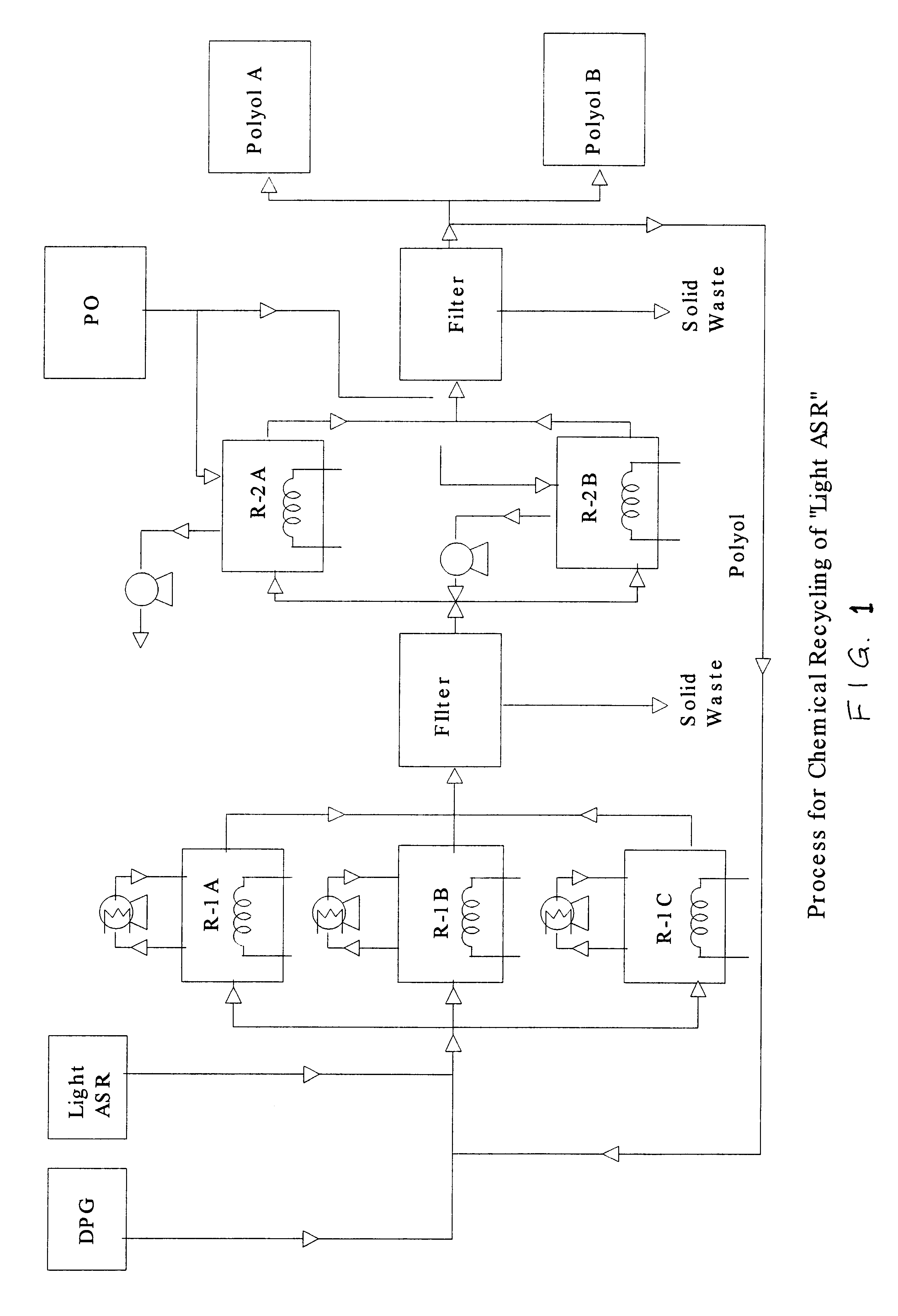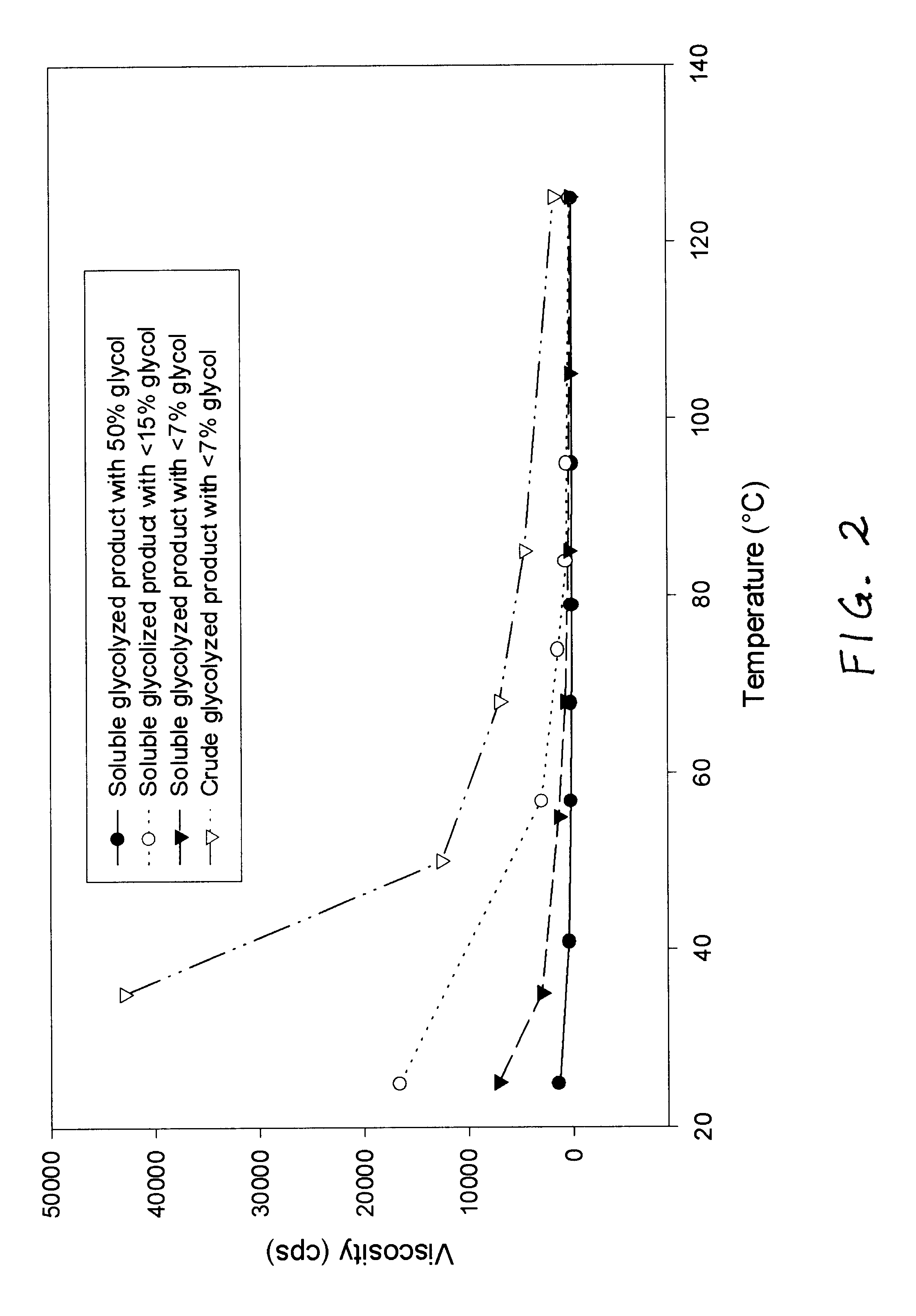Process for chemical recycling of polyurethane-containing scrap
a technology of polyether-based polyurethane and scrap, which is applied in the direction of plastic recycling, recycling and recovery technologies, etc., can solve the problems of affecting the reactivity of isocyanate chemolysis products, process is limited to the use of polyether-based polyurethane, and process is also limited to an alkanolamin
Inactive Publication Date: 2004-06-15
TROY POLYMERS
View PDF24 Cites 28 Cited by
- Summary
- Abstract
- Description
- Claims
- Application Information
AI Technical Summary
Benefits of technology
"The invention relates to a process for recycling polyurethane scrap, such as light ASR, using chemolysis processes. The process involves depolymerizing the scrap using glycolysis, hydrolysis, or aminolysis, and producing polyols from the resulting depolymerization products. The polyols can then be used to prepare polyurethanes with useful properties. The process is efficient and effective in recycling polyurethanes, but there are challenges in obtaining a sustainable amount of scrap and a sustainable quality of the scrap."
Problems solved by technology
Practically all chemolysis processes including glycolysis result in amine formation which greatly affects the reactivity of the chemolysis products with isocyanates.
Regardless of all these modifications, the final chemolysis products have extremely broad molecular weight distributions and only a limited amount can be used in a mixture with virgin polyols to prepare polyurethanes with useful properties.
The process is limited to the use of polyether-based polyurethanes.
The process is also limited to an alkanolamine (more specifically diethanolamine) as a chemolysis liquid reactant.
Another challenge for recycling in general and especially polyurethanes is obtaining a sustainable amount of the scrap and a sustainable quality of the scrap.
In the case of the post-consumer scrap, there are several challenges including collection and storage, transportation of usually light materials to long destinations, classification and characterization of materials without any control of their history during their service life and their history as scrap.
Scrap may be contaminated with other organic and inorganic materials including some potentially hazardous materials.
Method used
the structure of the environmentally friendly knitted fabric provided by the present invention; figure 2 Flow chart of the yarn wrapping machine for environmentally friendly knitted fabrics and storage devices; image 3 Is the parameter map of the yarn covering machine
View moreImage
Smart Image Click on the blue labels to locate them in the text.
Smart ImageViewing Examples
Examples
Experimental program
Comparison scheme
Effect test
example 6
(Hypothetical)
The glycolyzed products of Examples 1-5 could be used as initiators in reaction with propylene oxide and / or ethylene oxide to prepare propoxylated and / or ethoxylated polyol products. The polyol products could then be used to prepare a polyurethane foam. For example, a flexible polyurethane foam could be prepared utilizing the approximate formulation shown in Table 7.
the structure of the environmentally friendly knitted fabric provided by the present invention; figure 2 Flow chart of the yarn wrapping machine for environmentally friendly knitted fabrics and storage devices; image 3 Is the parameter map of the yarn covering machine
Login to View More PUM
| Property | Measurement | Unit |
|---|---|---|
| pressures | aaaaa | aaaaa |
| temperatures | aaaaa | aaaaa |
| glass transition temperature | aaaaa | aaaaa |
Login to View More
Abstract
A process of chemically recycling polyurethane-containing scrap. Polyurethane-containing scrap is subjected to a chemolysis reaction to produce chemolysis polyol products. The chemolysis polyol products are used as initiators in a reaction with alkylene oxide to produce oxyalkylated polyols for preparing polyurethanes.
Description
This invention relates in general to chemical recycling processes, and in particular to a process for the chemical recycling of polyurethane-containing scrap, such as light fraction separated from automotive shredder residue (hereinafter referred to as "light ASR") or flexible foam separated from automotive shredder residue. The invention also relates to novel polyol products, produced by the process, for preparing polyurethanes.BACKGROUND INFORMATIONIt is well known in the art that chemolysis processes such as glycolysis, hydrolysis, and aminolysis can be used for depolymerization and recycling of polyurethane scrap, as well as condensation polymers such as polyesters (e.g., PET), polyamides (e.g., nylons), and polyureas (e.g., RIM, RRIM, SRIM). Major differences between glycolysis, hydrolysis, and aminolysis are in the type of reactant utilized for depolymerization and the composition of final products. In the case of hydrolysis, water is utilized for decrosslinking of the polymer...
Claims
the structure of the environmentally friendly knitted fabric provided by the present invention; figure 2 Flow chart of the yarn wrapping machine for environmentally friendly knitted fabrics and storage devices; image 3 Is the parameter map of the yarn covering machine
Login to View More Application Information
Patent Timeline
 Login to View More
Login to View More Patent Type & Authority Patents(United States)
IPC IPC(8): C08G65/26C08G65/00C08J11/00C08J11/24C08G18/00C08G18/48C08G18/83
CPCC08G18/4837C08G18/831C08G65/2606C08G65/2609C08J11/24C08G2101/0008C08G2101/0083C08J2375/04Y02W30/62C08G2110/0083C08G2110/0008
Inventor SENDIJAREVIC, VAHID
Owner TROY POLYMERS
Features
- R&D
- Intellectual Property
- Life Sciences
- Materials
- Tech Scout
Why Patsnap Eureka
- Unparalleled Data Quality
- Higher Quality Content
- 60% Fewer Hallucinations
Social media
Patsnap Eureka Blog
Learn More Browse by: Latest US Patents, China's latest patents, Technical Efficacy Thesaurus, Application Domain, Technology Topic, Popular Technical Reports.
© 2025 PatSnap. All rights reserved.Legal|Privacy policy|Modern Slavery Act Transparency Statement|Sitemap|About US| Contact US: help@patsnap.com


